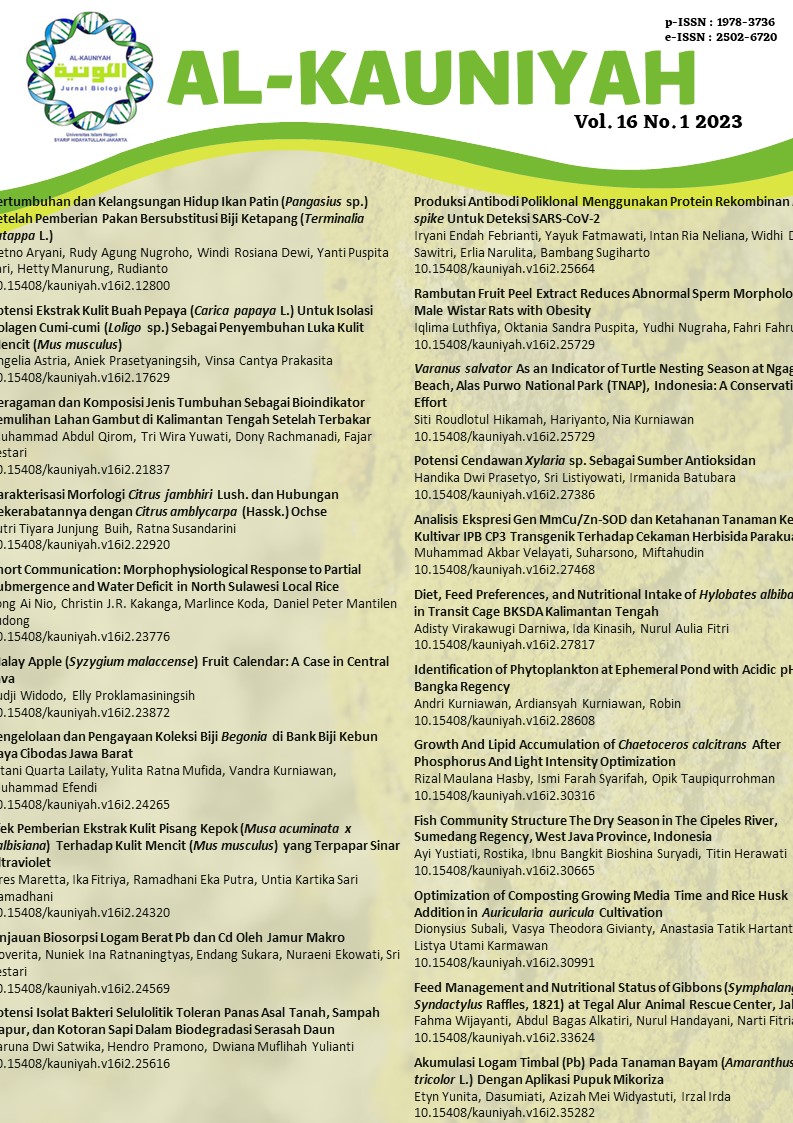Analisis Ekspresi Gen MmCu/Zn-SOD dan Ketahanan Tanaman Kentang Kultivar IPB CP3 Transgenik Terhadap Cekaman Herbisida Parakuat
DOI:
https://doi.org/10.15408/kauniyah.v16i2.27468Keywords:
Ekspresi gen, Herbisida parakuat, MmCu/Zn-SOD, Paraquat herbicide Gene expression,Abstract
Abstrak
Penggunaan herbisida parakuat untuk mengendalikan pertumbuhan gulma telah menjadi metode yang paling umum. Namun, penggunaan herbisida juga dapat menyebabkan kematian sel tanaman kentang yang sedang dibudidayakan, karena herbisida parakuat dapat menginduksi pembentukan senyawa Reactive Oxygen Species (ROS) yang dapat merusak sel tanaman. Ekspresi berlebih dari gen MmCu/Zn-SOD diharapkan dapat memberikan ketahanan tanaman terhadap cekaman herbisida parakuat. Penelitian ini bertujuan untuk menganalisis ekspresi gen MmCu/Zn-SOD pada kentang transgenik IPB CP3 kultivar dan ketahanannya terhadap cekaman herbisida parakuat. Perlakuan herbisida parakuat dengan konsentrasi 75 µM pada tanaman transgenik (P3SOD6, P3SOD9, P3SOD17) dan non-transgenik (NT) secara in vitro menunjukkan bahwa semua tanaman transgenik lebih tahan terhadap cekaman parakuat dibandingkan tanaman non-transgenik. Klon P3SOD9 paling tahan terhadap herbisida parakuat, dengan perbandingan 10 tanaman hidup dari 12 tanaman yang diuji. Ekspresi gen MmCu/Zn-SOD pada galur transgenik lebih tinggi dibandingkan galur non-transgenik. Ekspresi relatif gen MmCu/Zn-SOD pada P3SOD9, P3SOD6, dan P3SOD17 secara berturut-turut lebih tinggi 233,22; 127,62; dan 3,18 kali dibandingkan ekspresi gen tersebut pada NT. Semakin tinggi ekspresi gen MmCu/ZnSOD, semakin tinggi ketahanan terhadap cekaman herbisida parakuat.
Abstract
The use of paraquat herbicide to control weed growth has become the most common method. However, using the herbicide can also cause cell death in potato plants that are being cultivated because it can induce the formation of Reactive Oxygen Species (ROS) compounds that can damage plant cells. Overexpression of the MmCu/Zn-SOD gene is expected to provide resistance to paraquat herbicide stress. The study aimed to analyze the expression of the MmCu/Zn-SOD gene in transgenic potato cultivar IPB CP3 and its resistance to paraquat herbicide stress. In vitro treatment of transgenic (P3SOD6, P3SOD9, P3SOD17) and non-transgenic (NT) potato with 75 µM paraquat herbicide showed that all transgenic plants were more resistant to paraquat stress than that non-transgenic plants. The P3SOD9 clone was the most resistant to paraquat herbicide, with a ratio of 10 surviving plants of the 12 tested plants. The expression of MmCu/Zn-SOD in transgenic lines was higher than that in non-transgenic lines. The relative expressions of MmCu/Zn-SOD gene in P3SOD9, P3SOD6, and P3SOD17 were 233.22; 127.62; and 3.18 times higher than that of NT, respectively. The expression level of MmCu/ZnSOD correlates with the level of resistance to paraquat herbicide stress.
References
Ananieva, E. A., Christov, K. N., & Popova, L. P. (2004). Exogenous treatment with salicylic acid leads to increased antioxidant capacity in leaves of barley plants exposed to paraquat. Journal of Plant Physiology, 161(3), 319-328.
Anjum, N. A., Gill, S. S., Gill, R., Hasanuzzaman, M., Duarte, A. C., Pereira, E., … Tuteja, N. (2014). Metal/metalloid stress tolerance in plants: role of ascorbate, its redox couple, and associated enzymes. Protoplasma, 251(6), 1265-1283.
Badan Pusat Statistik. (2021). Statistik tanaman sayuran dan buah-buahan semusim Indonesia. Jakarta: BPS.
Basu, U., Good, A., & Taylor, G. (2001). Transgenic Brassica napus plants overexpressing aluminium‐induced mitochondrial manganese superoxide dismutase cDNA are resistant to aluminium. Plant, Cell & Environment, 24(12), 1278-1269.
Berk, A. J. (2016). Discovery of RNA splicing and genes in pieces. Proceeding of the National Academy of Science, 113(4), 801-805.
Bonneh-Barkay, D., Reaney, S. H., Langston, W. J., & Di Monte, D. A. (2005). Redox cycling of the herbicide paraquat in microglial cultures. Molecular Brain Research, 134(1), 52-56.
Che, Y., Zhang, N., Zhu, X., Li, S., & Wang, S., Si, H. (2020). Enhanced tolerance of the transgenic potato plants overexpressing Cu/Zn superoxide dismutase to low temperature. Scientia Horticulturae, 261, 108949.
Dong, S., Shew, D. H., Tredway, L. P., Lu, J., Sivamani, E., Miller, E. S., & Qu, R. (2008). Expression of the bacteriophage T4 lysozyme gene in tall fescue confers to gray leaf spot and brown patch disease. Transgenic Research, 17, 47-57.
Green, M. R., & Sambrook, J. (2018). A single-step method for the simultaneous preparation of DNA, RNA, and protein from cells and tissues. Cold Spring Harbor Protocols, 2018(1), 64-67
Hannum, S. (2012). Isolasi, pengklonan, dan analisis ekspresi gen penyandi copper/zinc superoxide dismutase (Cu/Zn-SOD) dari Melastoma malabathricum L. (Disertasi doktoral). Institut Pertanian Bogor, Jawa Barat, Indonesia
Livak, K. J., & Schmittgen, T. D. (2001). Analysis of relative gene expression data using real-time quantitative PCR and the 2− ΔΔCT method. Methods, 25(4), 402-408.
McKersie, B. D., Bowley, S. R., Harjanto, E., & Leprince, O. (1996). Water-deficit tolerance and field performance of transgenic alfalfa overexpressing superoxide dismutase. Plant Physiology, 111(4), 1177-1181.
Murashige, T., & Skoog, F. (1962) A revised medium for rapid growth and bio assays with tobacco tissue cultures. Plant Physiology, 15, 473-497.
Puteri, M. P. (2022). Perakitan tanaman kentang transgenik kultivar IPB CP3 dengan gen MmCu/Zn SOD (Tesis master). Institut Pertanian Bogor, Jawa Barat, Indonesia
Qian, H., Chen, W., Sun, L., Jin, Y., Liu, W., & Fu, Z. (2009). Inhibitory effects of paraquat on photosynthesis and the response to oxidative stress in Chlorella vulgaris. Ecotoxicology, 18(5), 537-543.
Radwan, D. E. M., Fayez, K. A., Mahmoud, S. Y., & Lu, G. (2010). Modifications of antioxidant activity and protein composition of bean leaf due to Bean yellow mosaic virus infection and salicylic acid treatments. Acta Physiologiae Plantarum, 32(5), 891-904.
Sharma, P., Jha, A. B., Dubey, R. S., & Pessarakli, M. 2012. Reactive oxygen species, oxidative damage, and antioxidative defense mechanism in plants under stressful conditions. Journal of Botani, 7(12),1-26.
Simms, D., Cizdziel, P. E., & Chomczynski, P. (1993). TRIzol: A new reagent for optimal single-step isolation of RNA. Focus, 15(4), 532-535.
Springer, M. N., Lisch, D., & Li, Q. (2016). Creating order from chaos: Epigenome dynamics in plants with complex genomes. The Plant Cell, 28, 314-325
Suharsono. (2002). Konstruksi pustaka genom kedelai kultivar slamet. Hayati, 9(3), 67-70.

